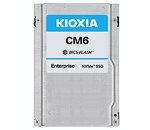Wednesday, November 13th 2019
KIOXIA PCIe 4.0 Enterprise NVMe SSDs Take Storage Performance to New Heights
KIOXIA America, Inc. (formerly Toshiba Memory America, Inc.), the U.S.-based subsidiary of KIOXIA Corporation, today announced that its lineup of PCIe 4.0 NVMeTM enterprise solid state drives (SSDs) has achieved PCI-SIG compliance for PCIe 4.0 and University of New Hampshire InterOperability Laboratory (UNH-IOL) certification. KIOXIA's CM6 Series successfully passed interoperability tests at the August 2019 PCI-SIG Compliance Workshop - the first workshop to include official PCIe 4.0 specification tests. KIOXIA America will be on hand at Supercomputing 2019 later this month to showcase new levels of flash performance enabled by its CM6 Series SSDs.
The first company to publicly demonstrate PCIe 4.0 SSDs, KIOXIA has established itself as a leader in developing PCIe 4.0 NVM Express SSDs and continues to push the limits of flash storage performance. The CM6 Series brings planned performance improvements of 3x over its PCIe 3.0 predecessors and is 12x faster than SATA drives. KIOXIA's lineup of Gen4 PCIe SSDs also includes the CD6 Series, which is targeted to cloud and scale-out environments.Key Features:
PCI-SIG hosts Compliance Workshops several times a year in various locations worldwide, giving members the opportunity to test and validate their products before entering the field. Compliance testing is completed against both PCI-SIG maintained systems and other leading manufacturers of PCI products. As the leading testing and certification lab for NVMe technology and software, the UNH-IOL provides conformance and interoperability testing across various operating systems, drivers, and hardware platforms, as well as PCIe SSDs and PCIe-enabled servers. "The SSD market is quickly moving to NVM Express technology, and standards compliance is critical to ensure smooth adoption," added Toledo.
The first company to publicly demonstrate PCIe 4.0 SSDs, KIOXIA has established itself as a leader in developing PCIe 4.0 NVM Express SSDs and continues to push the limits of flash storage performance. The CM6 Series brings planned performance improvements of 3x over its PCIe 3.0 predecessors and is 12x faster than SATA drives. KIOXIA's lineup of Gen4 PCIe SSDs also includes the CD6 Series, which is targeted to cloud and scale-out environments.Key Features:
- Utilizes KIOXIA's 96-layer BiCS FLASH 3D flash memory
- PCIe 2x2 or 1x4 lane configuration options
- Targeted transfer rates up to 6,900 MB/s
- Supports SFF-TA-1001 (also known as U.3) operation with Universal Backplanes for simplified customer use with SAS, SATA and NVMe SSDs
PCI-SIG hosts Compliance Workshops several times a year in various locations worldwide, giving members the opportunity to test and validate their products before entering the field. Compliance testing is completed against both PCI-SIG maintained systems and other leading manufacturers of PCI products. As the leading testing and certification lab for NVMe technology and software, the UNH-IOL provides conformance and interoperability testing across various operating systems, drivers, and hardware platforms, as well as PCIe SSDs and PCIe-enabled servers. "The SSD market is quickly moving to NVM Express technology, and standards compliance is critical to ensure smooth adoption," added Toledo.

5 Comments on KIOXIA PCIe 4.0 Enterprise NVMe SSDs Take Storage Performance to New Heights
This explanation requires a little history, you see back when NVMe drives first hit the scene there were two main types set up to take over from the older SATA SSDs (not counting PCI-E slot in cards). In the desktop form factor 2.5" SATA SSDs were set to be replaced by 2.5" U.2 NVMe SSDs (the U.2/SAS connector having already seen success in the enterprise market), and in the laptop form factor MSATA SSD's were set to be replaced by M.2 SSDs.
You will probably have noticed that never ended up happening and we use M.2 in desktops as well as laptops.
What transpired was that motherboard manufacturers (who had been putting laptop MSATA sockets on many of their boards for some time at this point) decided to simply put one or more M.2 sockets on their new boards, in order to enable the use of the new laptop M.2 NVMe SSDs on motherboards (as they figured consumers would only be likely to use one or two NVMe drives anyway) and most of them did this instead of fitting a U.2 port. As a result consumer SSD manufacturers concentrated pretty much entirely on the laptop M.2 form factor and (IIRC) only Intel actually brought out 2.5" NVMe drives (which IMO is a shame as they run a lot cooler and as a result lose less performance under load).